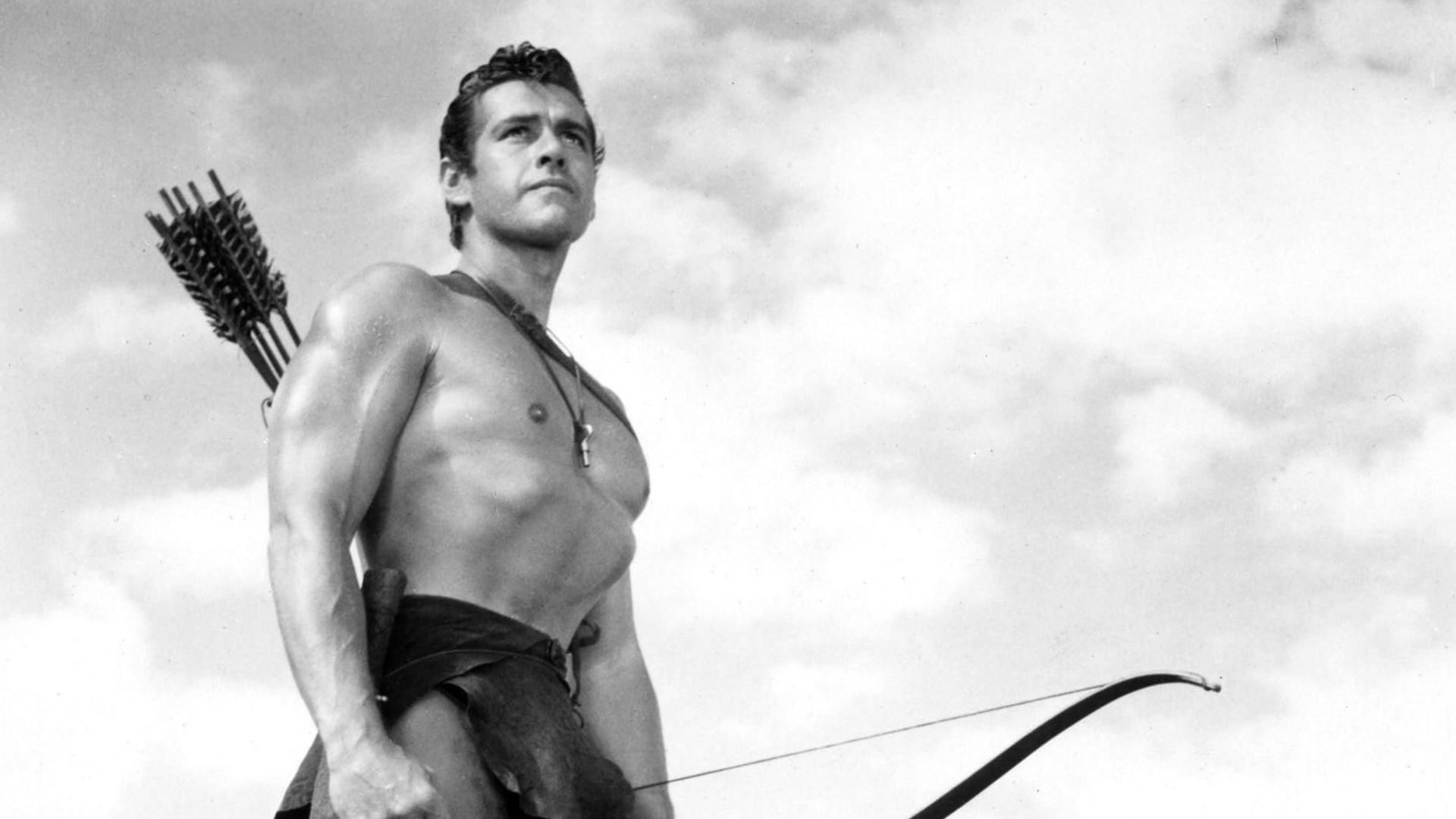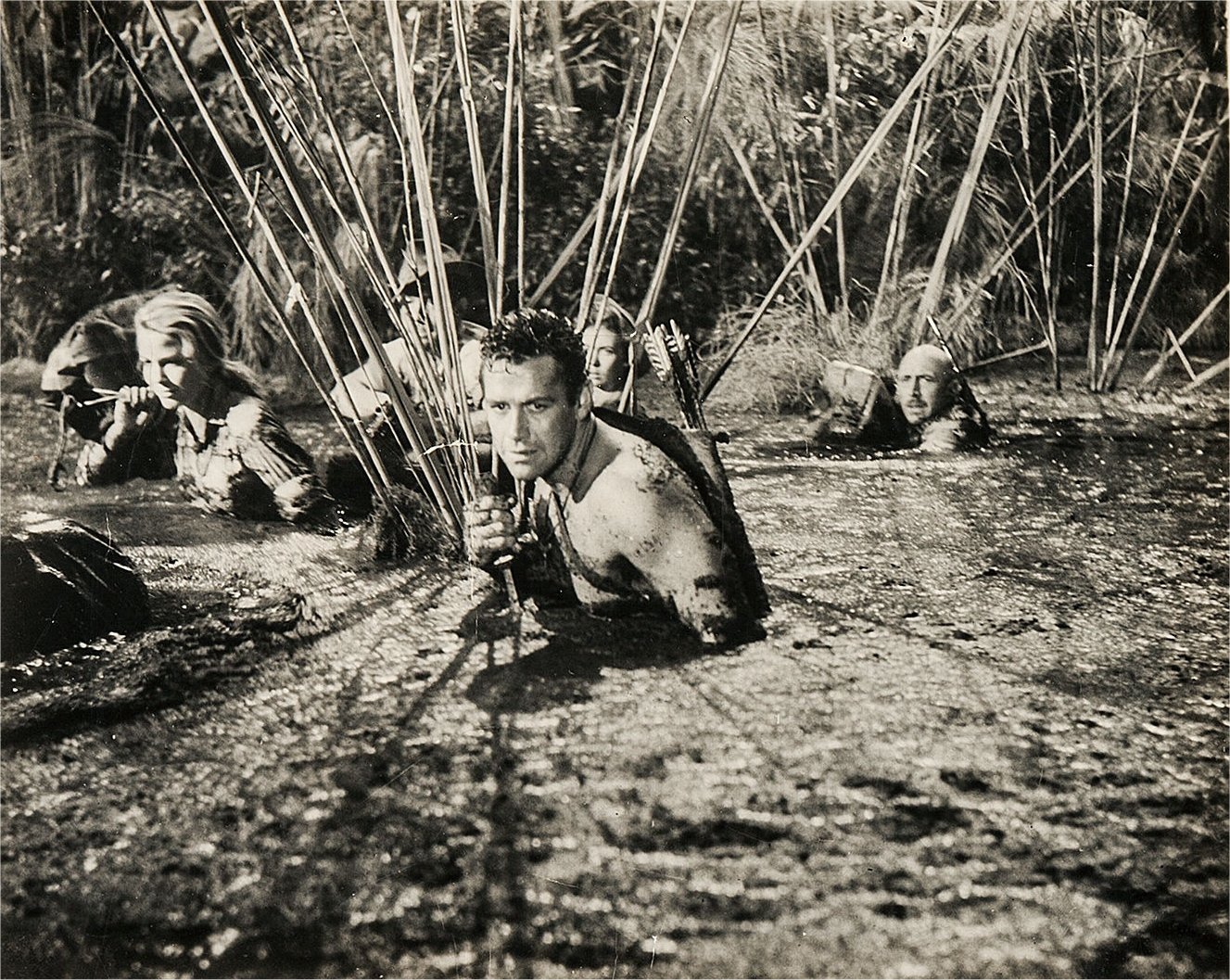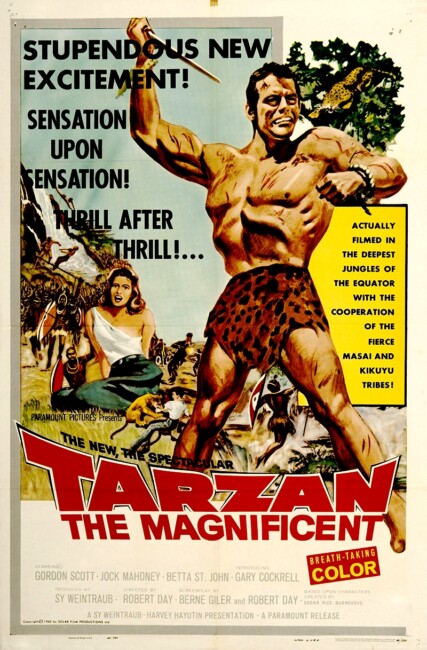USA. 1960.
Crew
Director – Robert Day, Screenplay – Robert Day & Bernie Giler, Producer – Sy Weintraub, Photography – Ted Scaife, Music – Ken Jones, Art Direction – Ray Simm. Production Company – Solar Film Productions.
Cast
Gordon Scott (Tarzan), Jock Mahoney (Coy Banton), Lionel Jeffries (Ames), John Carradine (Abel Banton), Betta St. John (Fay Ames), Charles Tingwell (Conway), Earl Cameron (Tate), Alexandra Stewart (Lori), Al Mulock (Martin Banton), Gary Cockrell (Johnny Banton), Christopher Carlos (Native Chief), Harry Baird (Warrior Leader), John Sullivan (Inspector Wyntors), Ewen Solon (Dexter), Peter Howell (Dr Blake), Jacqueline Evans (Mrs Dexter), Ron McDonnell (Ethan Banton), John Harrison (N’Como)
Plot
After the Banton family conduct an armed robbery in Africa, local police officer Inspector Wyntors sneaks into their camp and arrests Coy Banton. As Wyntors takes Coy back to be tried, the rest of the Banton clan ambush his boat and the freed Coy kills Wyntors. Tarzan is nearby and apprehends Coy, determining to take him for trial at Kairobi so that the reward money can go to Wyntors’ family. He sets out but family patriarch Abel Banton and his other sons come in pursuit, attacking and setting fire to the riverboat by which Tarzan was planning to journey. Tarzan instead decides he will travel to Kairobi by foot with Coy as prisoner. He reluctantly agrees to allow a group of Western travellers who have been abandoned by the burning of the riverboat to accompany him. All the way, they are pursued by Abel and sons who determinedly track their trail. Meanwhile, Coy seeks every opportunity to use the party’s weaknesses against them in order to betray their position and make an escape.
The character of Tarzan, created by Edgar Rice Burroughs, has a long history on cinema screens, particularly during the early half of the 20th Century, beginning with the silent Tarzan of the Apes (1918). The most famous incarnation came with Johnny Weissmuller in Tarzan the Ape Man (1932) who went onto play the part in eleven other films with the series moving studio from MGM to RKO Radio Pictures partway through. Weissmuller left the series in 1949 and the loincloth was inherited by Lex Barker for a further five films. After Barker’s run, the role was taken up by former military policeman and lifeguard Gordon Scott for five films beginning with Tarzan’s Hidden Jungle (1955). Tarzan the Magnificent would be Scott’s final outing in the role. (See below for the other Gordon Scott Tarzan films).
MGM had reduced the Tarzan film to a dreary formula (which in turn was parroted by the RKO entries) – of Tarzan and Jane in cute domestics in the treehut surrounded by Cheeta and the animals who increasingly came to dominate the show with their comedy relief antics, and fairly interchangeable plots about natives, white explorers/trappers and lost cities. None of the adventures ever went beyond obvious studio backlot jungles.
Enter producer Sy Weintraub who took over the Tarzan series from RKO in 1958 and produced a series of seven Tarzan films – Tarzan’s Greatest Adventure (1959) and Tarzan the Magnificent here with Gordon Scott, the subsequent Tarzan Goes to India (1962) and Tarzan’s Three Challenges (1963) with Jock Mahoney in the role, and Tarzan and the Valley of Gold (1966), Tarzan and the Great River (1968) and Tarzan and the Jungle Boy (1968) with Mike Henry, as well as the tv series Tarzan (1966-8) starring Ron Ely.

Sy Weintraub’s innovation was to throw out the cutsie comedy relief elements that had come in in the Johnny Weissmuller films, to have Tarzan speak proper English (as he did in the original Edgar Rice Burroughs books), eliminating Boy and Jane, while shooting the adventures in colour and more importantly going to film in Africa, as well as other exotic locales like India, Thailand, Mexico and Brazil. The opening credits of the film here, for instance, note proudly “that this film was made in Africa” and that it was filmed with the cooperation of the Kenyan Government and the Kiyuku and Masai tribes. Indeed, just the way the film opens on a tribal dance is clear that this is no cheap MGM backlot adventure. Almost all fans of the Tarzan films cite the Sy Weintraub adventures as among the best of the films.
Under British director Robert Day, who also co-writes the script and would go onto make three other Tarzan films under Sy Weintraub, the film comes with a good gritty action focus. The scene where John Carradine’s villain attacks the riverboat, killing its crew and abandoning the passengers ashore before setting it alight has a brutality to it that kicks the Weissmuller films out of the ring. Unlike the cute, cuddly feelgood Tarzan of the Weissmuller series, Gordon Scott’s Tarzan is happy to kill people.
Robert Day also plays up the tensions inside the party well, particularly the way that prisoner Jock Mahoney plays them off against each other and even the striking scene where he seems to seduce Lionel Jeffries’ wife Betta St. John into betraying the party. On the minus side, the pursuit is never as tight and dramatic as you expect it to be – although that could well be the expectations of a modern film coming into play. There are however some good individual dramatic set-pieces such as the arrival at the native village and the saving of the chief’s infant.

Gordon Scott was never one of the better actors cast as Tarzan. By this point, Scott had at least moved out of the handsomely wooden persona he affected in his earlier films and gives a cross and determined performance. The problem is that with the pidgin English dialogue of the Weissmuller characterisation having been eliminated and with the films not yet having discovered the incarnation of Tarzan as long-haired eco-warrior that came in in the 1980s, Scott seems no more than a standard cleancut action hero of the era. As such, he comes as less wild man who has lived all his life in the jungle and more as law enforcement official who looks as though he belongs in a contemporary detective thriller.
It is hard to believe that Jock Mahoney, who plays with an insolent expression throughout, would become Gordon Scott’s successor as Tarzan. The climax is interesting in hindsight where we get to see the two screen Tarzans fighting together where, even though Mahoney only has an inch in height over Gordon Scott in real-life, he has a physicality that makes him looks at least a foot taller, unfortunately causing Scott to look the slighter of build in contrast.
Gordon Scott’s other Tarzan films are:- Tarzan’s Hidden Jungle (1955), Tarzan and the Lost Safari (1957), Tarzan’s Fight for Life (1958), Tarzan and the Trappers (1958) and Tarzan’s Greatest Adventure (1959).
Director Robert Day made a number of other genre films, including two early British horror films The Haunted Strangler/Grip of the Strangler (1958) and Corridors of Blood (1962), as well as the British science-fiction film First Man Into Space (1959) and Hammer’s H. Rider Haggard adaptation She (1965). His other Tarzan films include – Tarzan’s Three Challenges (1963), Tarzan and the Valley of Gold (1967), Tarzan and the Great River (1968) and Tarzan and the Jungle Boy (1968). The majority of Day’s work in the 1970s and beyond was in television, where he made a number of genre tv movies including Ritual of Evil (1970) and The Initiation of Sarah (1978).
Trailer here


